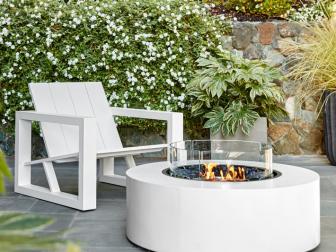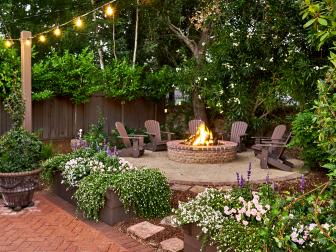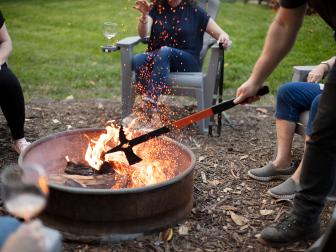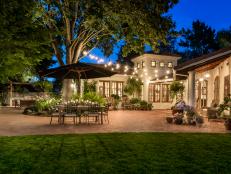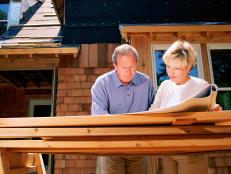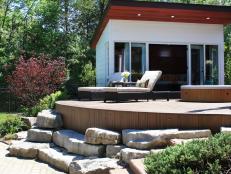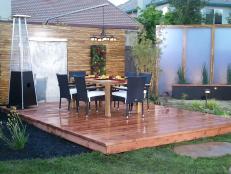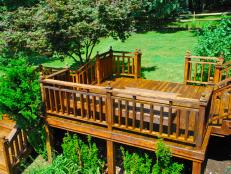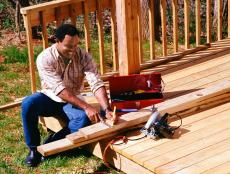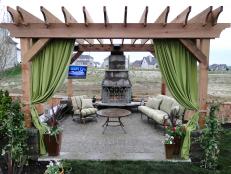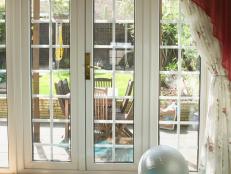Gas Fire Pits: Propane vs. Natural Gas
Which fuel is best for your fire pit — propane or natural gas? Learn about the pros and cons of propane and natural gas fire pits.
An outdoor gas fire pit blazes with flames that float, drift and flicker — all at the flip of a switch. There’s no wood to split, no stoking required, and you’ll enjoy the same cozy ambiance a wood-fueled fire provides, minus the smoke and ashes. Gas fire pits feature a range of design styles, from small, portable fire tables to permanent family-sized fire pits.
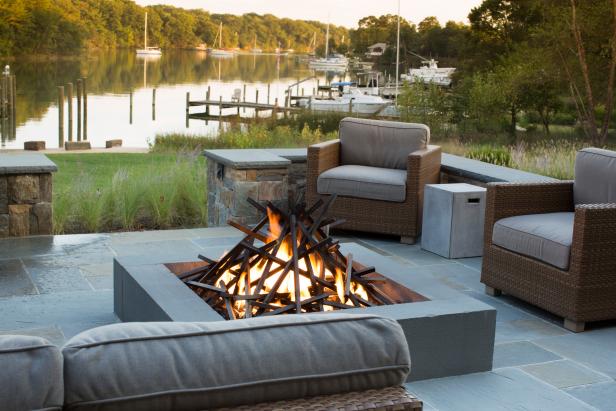
David Burroughs Photography
This unique gas fire pit has a sculptural feature that makes it looks as if it is burning real wood.
When you’re choosing a gas fire pit, some of the most common questions relate to fuel. What’s the difference between natural gas and propane? Is one better than the other? What advantages does each fuel offer? Are there any significant downsides to propane or natural gas? Get the answers you need by learning about propane vs. natural gas fire pits.
What Is Propane?
Propane is refined natural gas. Because it’s refined, it burns hotter, actually producing twice as much heat as an equal amount of natural gas. Propane is liquefied and stored in tanks that are easy to store and transport.
Rural homes located where there are no natural gas lines often heat with liquid propane, which is delivered by truck. You’re probably familiar with liquid propane in 20-pound tanks, the size that fuels most gas grills. Those tanks are widely available, from big-box stores to neighborhood grocery stores.
12 Best Propane Fire Pits
Cool or warm evenings, roasting hot dogs or marshmallows, small or large gatherings — fire pits are the ultimate hangout spot. Discover which gas fire pit is the right fit for your outdoor space and what to consider before buying.
Pros + Cons of Propane Fire Pits
The big advantage of a propane fire pit is that it’s easy to set up. If you can change out the gas tank on your grill, you can handle setting up a propane fire pit. The exception to this is if you choose to plumb your propane fire pit directly to a large on-site tank. At that point, you’ll probably need to hire a professional.
Many propane fire pits are portable. That means you can take your fire pit on the road — camping, to family gatherings or even tailgating (if the site permits open flames). A propane flame burns brightly, allowing you to see it easily during daylight hours, even when the sun is shining.
When it comes to heat, a propane fire pit is more efficient than natural gas, cranking out a warmer heat. Because a propane fire pit isn’t usually a permanent landscape addition, most often it’s cheaper to install than a natural gas fire pit.

Propane fire pits are portable, but require a propane tank to run them. Here, the propane tank is hidden in a side table (right) and the hose is run between the table and the fire pit.
Are there any downsides to a propane fire pit? You will need to refill the propane tank over time. A 20-pound propane tank lasts, on average, four to four-and-a-half hours at a continuous burn at maximum output. At a moderate gas output, expect the tank to last eight or nine hours. It’s a good idea to keep an extra tank on hand, especially if you do a weekly fire or are hosting friends and family for a gathering.
Despite the fact that propane is a more efficient fuel, a propane fire pit ultimately is more expensive to operate than a natural gas fire pit.
With many propane fire pits, the tank is visible. Some models are large enough that they include space for a tank below or beside the fire pit. Or you can buy or build a stand to house the tank, essentially hiding it inside a piece of patio furniture. The connection hose is also usually visible with most propane fire pits, but you can find clever and creative ways to hide it by searching online.

A propane fire pit flame is bright enough to be seen easily even on a sunny day.
What Is Natural Gas?
Natural gas is mostly methane, but also contains propane, butane and a few other gases. On the whole, natural gas is cheaper than propane and burns cleaner, so there’s less of a bright yellow color to the flames. Natural gas is what you'll find in most commercial outdoor spaces that have a fire pit table for entertaining, mainly because it costs less to operate.
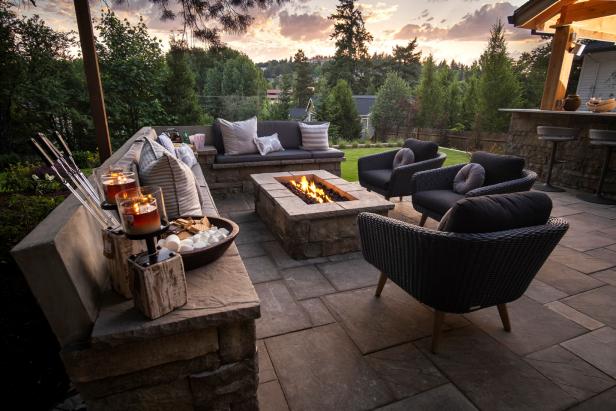
Bill Burk Photography
A natural gas fire pit is a permanent structure that can be a welcoming destination for entertaining and relaxing.
Pros + Cons of Natural Gas Fire Pits
For permanent fire pit installations, natural gas is the No. 1 choice. Why? Because once installed, it requires the least amount of maintenance. With a dedicated natural gas line, you don’t have to worry about refilling tanks or changing them out. You always have a ready supply of gas to fuel your fire.
A natural gas line to a fire pit is typically built into the outdoor living area. You don’t have to deal with a hose that needs to be hidden or secured so it doesn’t become a trip hazard.
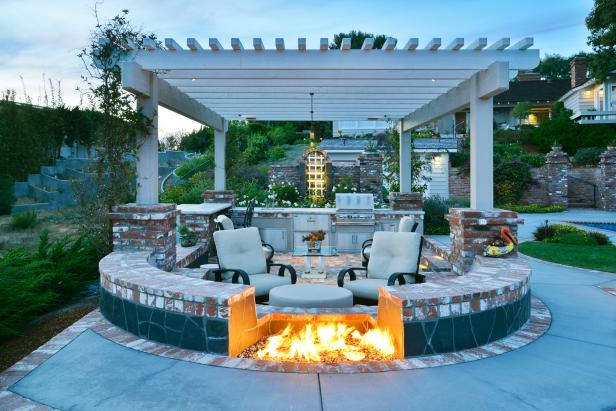
Martin Mann
This gas fire pit is built right into a permanent conversation pit.
Depending on how much pressure your gas line has, with a natural gas fire pit you can go high with the BTUs, which means greater, faster heat output. Because a natural gas fire pit is a permanent install, it tends to be tougher and more weather resistant than a propane fire pit. You can realistically expect a natural gas fire pit to last for decades with minimal maintenance. In some areas of the country, a natural gas fire pit increases your home value when it’s time to sell.
With a natural gas fire pit, you’ll need professional installation for the gas line and possibly the fire pit, depending on your DIY skills. Because it’s a permanent fixture, a natural gas fire pit tends to be costlier at the outset. You’ll also need to choose a fixed and final spot for your fire pit, because once it’s installed, it cannot be moved easily.
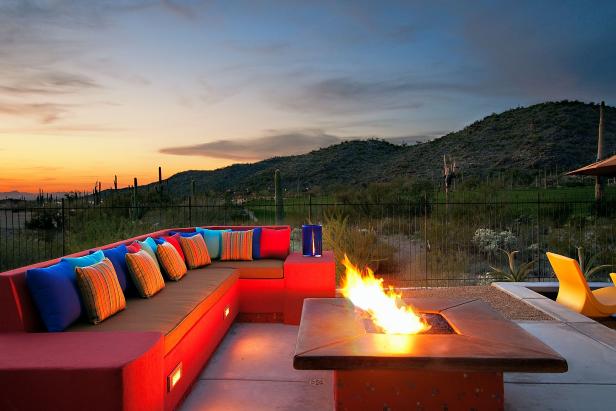
Elizabeth Przygoda-Montgomery
A cushioned outdoor sectional with an array of colorful pillows is a cozy place for guests to gather around the fire pit and enjoy the spectacular views.
Which Fuel Source Is Best?
That’s the million-dollar question. Whether a natural gas fire pit or a propane fire pit is best for your backyard really depends on several factors, including your goals, entertaining practices, long-term plans and budget. The size of your yard can also shape and influence your fire pit choices.
If you can’t easily decide which type of fire pit works best for you, consider meeting with a local landscaper who specializes in fire pits. Someone with experience in fire pit installation can help advise you on the best locations, styles and whether propane or natural gas is a better fit for your situation.








